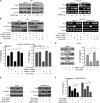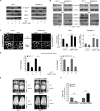Inhibition of epithelial to mesenchymal transition by E-cadherin up-regulation via repression of slug transcription and inhibition of E-cadherin degradation: dual role of scaffold/matrix attachment region-binding protein 1 (SMAR1) in breast cancer cells
- PMID: 25086032
- PMCID: PMC4162148
- DOI: 10.1074/jbc.M113.527267
Inhibition of epithelial to mesenchymal transition by E-cadherin up-regulation via repression of slug transcription and inhibition of E-cadherin degradation: dual role of scaffold/matrix attachment region-binding protein 1 (SMAR1) in breast cancer cells
Abstract
The evolution of the cancer cell into a metastatic entity is the major cause of death in patients with cancer. It has been acknowledged that aberrant activation of a latent embryonic program, known as the epithelial-mesenchymal transition (EMT), can endow cancer cells with the migratory and invasive capabilities associated with metastatic competence for which E-cadherin switch is a well-established hallmark. Discerning the molecular mechanisms that regulate E-cadherin expression is therefore critical for understanding tumor invasiveness and metastasis. Here we report that SMAR1 overexpression inhibits EMT and decelerates the migratory potential of breast cancer cells by up-regulating E-cadherin in a bidirectional manner. While SMAR1-dependent transcriptional repression of Slug by direct recruitment of SMAR1/HDAC1 complex to the matrix attachment region site present in the Slug promoter restores E-cadherin expression, SMAR1 also hinders E-cadherin-MDM2 interaction thereby reducing ubiquitination and degradation of E-cadherin protein. Consistently, siRNA knockdown of SMAR1 expression in these breast cancer cells results in a coordinative action of Slug-mediated repression of E-cadherin transcription, as well as degradation of E-cadherin protein through MDM2, up-regulating breast cancer cell migration. These results indicate a crucial role for SMAR1 in restraining breast cancer cell migration and suggest the candidature of this scaffold matrix-associated region-binding protein as a tumor suppressor.
Keywords: Cadherin-1 (CDH1) (Epithelial Cadherin) (E-cadherin); E3 Ubiquitin Ligase; Epithelial-Mesenchymal Transition (EMT); Metastasis; Migration.
© 2014 by The American Society for Biochemistry and Molecular Biology, Inc.
Figures







References
-
- Adhikary A., Mohanty S., Lahiry L., Hossain D. M. S., Chakraborty S., Das T. (2010) Theaflavins retard human breast cancer cell migration by inhibiting NF-κB via p53-ROS cross-talk. Febs. Lett. 584, 7–14 - PubMed
-
- Steeg P. S. (2006) Tumor metastasis: mechanistic insights and clinical challenges. Nature Med. 12, 895–904 - PubMed
-
- Savagner P. (2001) Leaving the neighbourhood: molecular mechanisms involved during epithelial-mesenchymal transition. BioEssays 23, 912–923 - PubMed
-
- Huber M. A., Kraut N., Beug H. (2005) Molecular requirements for epithelial–mesenchymal transition during tumor progression. Curr. Op. Cell Biol. 17, 548–558 - PubMed
-
- Thiery J. P. (2002) Epithelial-mesenchymal transition in tumor progression. Nat. Rev. Cancer 2, 442–454 - PubMed
Publication types
MeSH terms
Substances
LinkOut - more resources
Full Text Sources
Other Literature Sources
Medical
Research Materials
Miscellaneous

